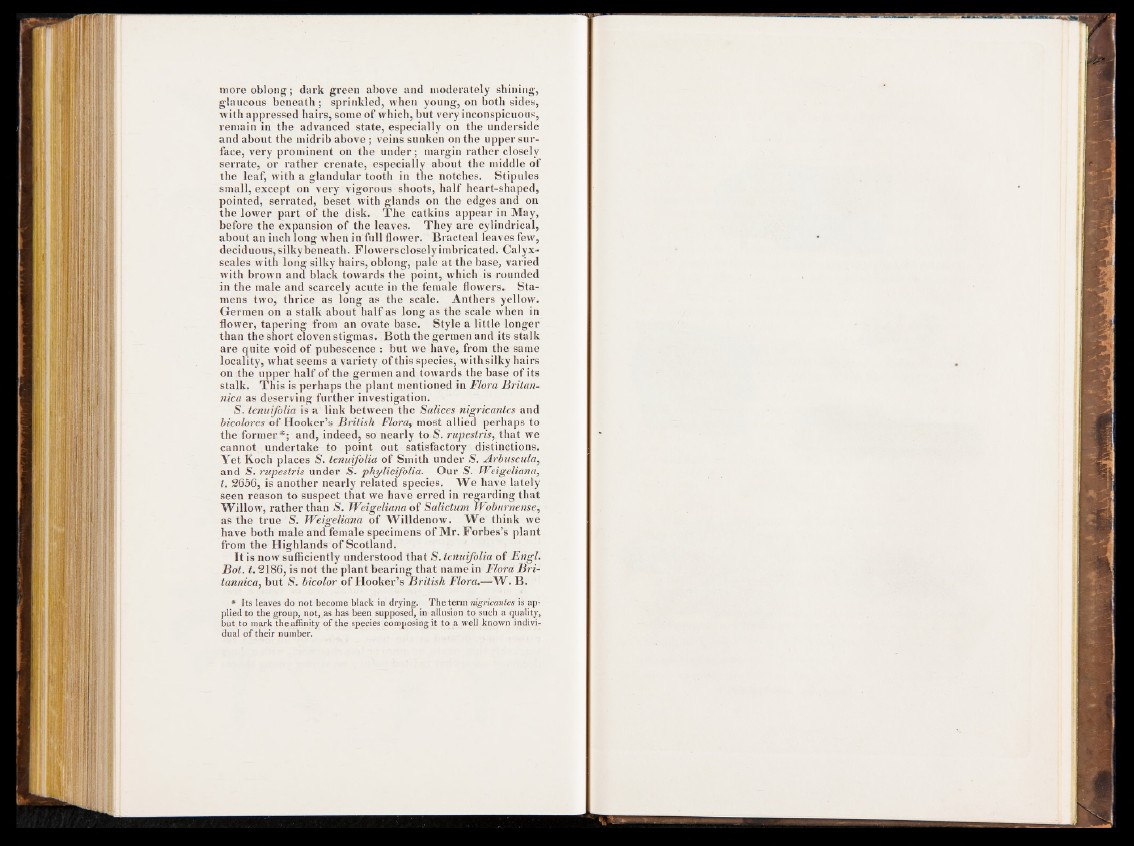
more oblong; dark green above and moderately shining,
glaucous beneath; sprinkled, when young, on both sides,
with appressed hairs, some of which, but very inconspicuous,
remain in the advanced state, especially on the underside
and about the midrib above ; veins sunken on the upper surface,
very prominent on the under; margin rather closely
serrate, or rather crenate, especially about the middle of
the leaf, with a glandular tooth in the notches. Stipules
small, except on very vigorous shoots, half heart-shaped,
pointed, serrated, beset with glands on the edges and on
the lower part of the disk. The catkins appear in May,
before the expansion of the leaves. They are cylindrical,
about an inch long when in full flower. Bracteal leaves few,
deciduous, silky beneath. Flowers closely imbricated. Calyx-
scales with long silky hairs, oblong, pale at the base, varied
with brown and black towards the point, which is rounded
in the male and scarcely acute in the female flowers., Stamens
two, thrice as long as the scale. Anthers yellow.
Germen on a stalk about half as long as the scale when in
flower, tapering from an ovate base. Style a little longer
than the short cloven stigmas. Both the germen and its stalk
are quite void of pubescence : but we have, from the same
locality, what seems a variety of this species, with silky hairs
on the upper half of the germen and towards the base of its
stalk. This is perhaps the plant mentioned in Flora Britan-
nica as deserving further investigation.
S. tenuifolia is a link between the Salices nigricantes and
bicolores of Hooker’s British Flora, most allied perhaps to
the former*; and, indeed, so nearly to S. rupestris, that we
cannot undertake to point out satisfactory distinctions.
Yet Koch places S. tenuifolia of Smith under S. Arbuscula,
and S'. rupestris under S. phylicifolia. Our S. TVeigeliana,
t. 2656, is another nearly related species. We have lately
seen reason to suspect that we have erred in regarding that
Willow, rather than S'. TVeigeliana of Salictum TV oburnense,
as the true S. TVeigeliana of Willdenow. We think we
have both male and female specimens of Mr. Forbes’s plant
from the Highlands of Scotland.
It is now sufficiently understood that S. tenuifolia of Engl.
Bot. t. 2186, is not the plant bearing that name in Flora Bri-
tannica, but S. bicolor of Hooker’s British Flora.—W. B.
* Its leaves do not become black in drying. The term nigricantes is applied
to the group, not, as has been supposed, in allusion to such a quality,
but to mark theaffinity of the species composing it to a well known individual
of their number.